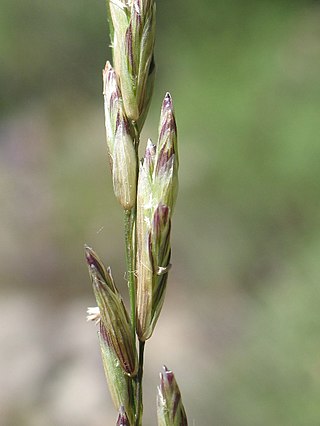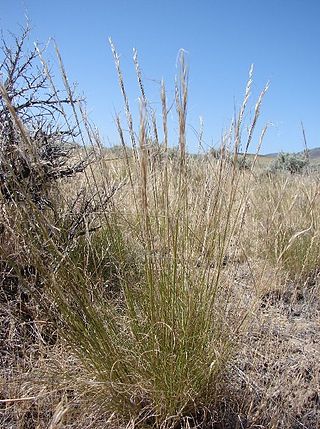
Danthonia intermedia is a species of grass known by the common names timber oatgrass, intermediate oatgrass, and mountain wild-oat grass. This clumping erect perennial grass is native to North America, where it is widespread across most of Canada and along the western United States into California. It is a plant of the plains as well as forested, mountainous, alpine environments.

Festuca subulata is a species of grass known by the common names bearded fescue and nodding fescue. It is native to the northwestern quarter of North America, from Alaska to South Dakota to northern California, where it is most often found in moist mountain forests.

Cynosurus echinatus is a species of grass known by the common names bristly dogstail grass, rough dog's-tail and hedgehog dogtail. It is native to southern Europe, and it is known in the Americas and Australia as an introduced species and sometimes a noxious weed. An herbicide-resistant strain can be found growing as a weed in canola and wheat fields in Chile. This is an annual grass growing 10 to 50 centimeters tall. The inflorescence is a rounded or oval cluster or series of clusters of spikelets. The fertile spikelet has an awn up to a centimeter long. The awns clumped closely together into a tuft gives the inflorescence its bristly, hairy appearance.

Melica californica is a species of grass known by the common name California melic.

Melica fugax is a species of grass known by the common names little oniongrass and little melic. It is native to western North America where it usually grows in volcanic soils in forest and plateau habitat from British Columbia to the Sierra Nevada and North California Coast Ranges in California.

Melica geyeri is a species of grass known by the common name Geyer's oniongrass.

Melica imperfecta is a species of grass known by the common name smallflower melic and little California melic.

Melica spectabilis is a species of grass known by the common names purple oniongrass and showy oniongrass.

Melica subulata is a species of grass known by the common name Alaska oniongrass.

Munroa squarrosa is a species of grass known by the common name false buffalograss. It is native to North America from central Canada to Chihuahua in Mexico. It can be found in many types of dry, open habitat, including disturbed areas.

Oloptum miliaceum is a species of grass known by the common name smilograss. It is native to Eurasia but it can be found in many other parts of the world as an introduced species and a casual weed of disturbed areas. It is a clumping perennial grass producing sturdy, erect stems that can reach 1.5 meters tall. The inflorescence is a panicle of several whorls of branches that divide into secondary branches bearing clusters of spikelets.

Pleuropogon refractus is a species of grass known by the common name nodding semaphoregrass. It is native to the west coast of North America from British Columbia to northern California, where it grows in moist meadows, marshy areas, and shady forests.

Poa bulbosa is a species of grass known by the common names bulbous bluegrass or bulbous meadow-grass. It is native to Eurasia and North Africa, but it is present practically worldwide as an introduced species. It is widespread in the United States and southern Canada. It was introduced to the eastern United States around 1906 and the western US in 1915 as a contaminant in shipments of alfalfa seed. It was intentionally planted on both the east and west coasts to control weeds and prevent erosion. Today it is a common grass across the continent and is a noxious weed in some areas. It is a sturdy, hardy, persistent, aggressive grass that easily outcompetes many other plants and becomes the dominant species in disturbed habitat types, such as overgrazed fields.

Poa macrantha is a species of grass known by the common names seashore bluegrass and large-flowered sand dune bluegrass. It is native to the west coast of North America from Alaska to northern California, where it grows in sand dunes and other beach habitat.

Poa unilateralis is a species of grass known by the common names San Francisco bluegrass, ocean-bluff bluegrass, and sea-bluff bluegrass.

Schoenoplectus tabernaemontani is a species of flowering plant in the sedge family known by the common names softstem bulrush, grey club-rush, and great bulrush. It can be found throughout much of the world; it has been reported from every state in the United States, and from every province and territory in Canada except Nunavut. It grows in moist and wet habitat, and sometimes in shallow water.

Vulpia microstachys is a species of grass known by the common names small fescue and small sixweeks grass. It is native to western North America from British Columbia to Colorado and New Mexico to Baja California, where it grows in many types of open habitat, including grasslands. It is dominant on some grasslands of California, and it was probably an abundant native grass before the habitat was altered by invasive non-native grasses. It occurs on serpentine soils with associates such as serpentine reedgrass. It is also known from parts of South America. It is an annual grass producing one stem or a clump of several stems growing up to 75 centimeters tall. The inflorescence has several open branches bearing clusters of purple-tinged spikelets. The spikelet has one to six flowers. The grass is usually cleistogamous, its flowers fertilizing themselves.

Eriocoma thurberiana is a species of grass known by the common name Thurber's needlegrass. It is native to the western United States, where it occurs from Washington to California and east to Montana and Wyoming.

Danthonia compressa is a species of grass known by the common names mountain oatgrass, flattened oatgrass, and slender oatgrass.

Hilaria mutica, synonym Pleuraphis mutica, is a species of grass known by the common name tobosa, or tobosa grass. It is native to Northern Mexico, and the Southwestern United States, in Arizona, New Mexico, Oklahoma, and Texas.




















